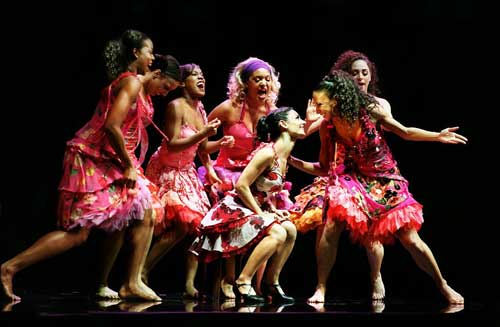West Side Story, Sadler's Wells, London<br/>Spartacus, Coliseum, London
The street violence in Bernstein's version of 'Romeo and Juliet' gives added power to its high-energy mix of danger and romance

Some things are timeless. In the 1950s, when oily quiffs were a grow-your-own kind of hoodie, Leonard Bernstein and Stephen Sondheim wrote a song called "Gee, Officer Krupke" that brilliantly anatomised the next half century's circular thinking on the topic of juvenile delinquency. From domestic abuse to drug addiction to drink to laziness, all the causes and cures are wittily anatomised and dismissed, by the delinquents themselves. Nobody, they conclude, wants a fella with a social disease. They never think of offering to visit stab victims though, which is a shame, because in this case it might do some good.
West Side Story at Sadler's Wells is remarkably fresh for a musical that's just turned 50 without a serious makeover. The choreographer Jerome Robbins, who conceived this New York update of Romeo and Juliet, wanted his steps pre-served, unadulterated. And since the show is driven by its dancing, all that changes is the decor – here a rusty skeleton of balconies and fire escapes, with grainy shots of Manhattan in the background.
The legend is misleading, though. The star-crossed lovers, Tony and Maria, meet at a dance but never really shake a leg. In West Side Story dancing is for the masses, the rival gangs of Jets and Sharks and their girlfriends, with Bernstein's score – angular, jazzy, locomotive with brass – pushing them on.
For Tony and Maria the music, and the musical, become softer, more static, reaching back for the warm comforts of operetta. But when the numbers include "Tonight" and "Maria" it's hard to quibble. One of the few jarring features is when Robbins' choreography intrudes on the loveliest of the major love songs. Everyone has their own personal "Somewhere" (even Tom Waits), and to impose a vision of a white-robed Elysium, with erstwhile rivals dancing in a big happy circle, on so elusive a wish feels simplistic and crass.
Bathos is used more effectively elsewhere, to point up the vulnerability of the lovers. In the first of two casts, Ryan Silverman and Sofia Escobar are a terrifyingly soft-shelled couple, perfect to be torn and shredded in the jaws of Robbins's abrasive, still shocking gangland choreography. Each succeeding death, and the rape of Maria's friend Anita, is kept short, surprising and brutal. Robbins knew how to stage violence so it doesn't become a swishy game of pattycake, a lesson you only wish other choreographers would learn.
In the St Petersburg-based Mikhailovsky Ballet's Spartacus, at the Coliseum, for example. In its defence, this is exactly the sort of entertainment that the more rolling-eyed Roman emperors would have programmed at the real Colosseum, between the serious business of killing things. Remember Bob Guccione's notorious, Vidal-scripted film Caligula? Well, if the Penthouse flesh-pedlar had cast Liberace in the title role, and then asked Paul Verhoeven to turn it into a musical, the result might well have looked like this.
There are giant masks, roving spotlights, men in cages, ruby-nippled whores, a dungeon keeper who looks as if he's come out of the Spiderwick Chronicles via a Victoria's Secret catalogue, and up to 200 extras having a riotous time as soldiers, slaves and orgiasts. And whatever the music or the mood, we're never more than a drumbeat away from a mass, shoulder-rolling shimmy.
Anastasia Matvienko fits in well as the courtesan Sabina, a dark-eyed schemer. Marat Shemiunov, as her lover, the patrician Crassus, is understandably in a permanent state of overexcitement. As is Andrei Bregvadze's General Pompeius, although there is nothing remotely understandable about his performance. Appearing first in gold lamé and then in a black-trimmed centurion's outfit (with glitter in the plume), he stamps around in a camp, arthritic frenzy, stealing every scene simply by being the most ludicrous thing on display.
Against Romans like these, all Denis Matvienko's Spartacus has to do to convey nobility is not look barking. Which is just as well because choreographer George Kovtun has a limited sense of the movements appropriate to a hero. Despite Matvienko's honest, manly dancing, and some anxiety-inducing furniture mover's lifts inflicted on a fatalistic Irina Perren, his Spartacus emerges as a bit of a killjoy. Against all expectations, I found myself rooting for the Romans, and came away from the theatre with a curious hankering for larks' tongues.
Subscribe to Independent Premium to bookmark this article
Want to bookmark your favourite articles and stories to read or reference later? Start your Independent Premium subscription today.

Join our commenting forum
Join thought-provoking conversations, follow other Independent readers and see their replies